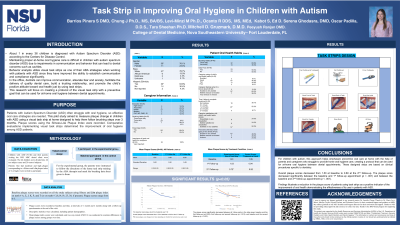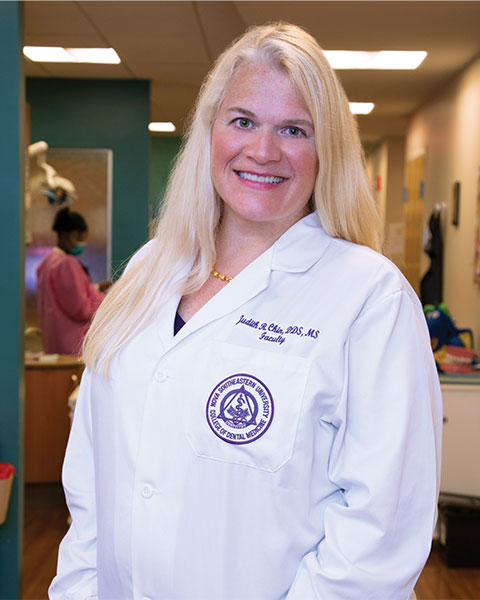Preventive
371 - Task Strip in Improving Oral Hygiene in Children with Autism


Susana Barrios Pinera, DMD (she/her/hers)
Pediatric Dentist Resident
847 W Plantation Circle
Nova Southeastern University College of Dental Medicine
Plantation, Florida, United States- SK
Susan Kabot, Ed.D
NSU College of Dental Medicine
- ML
Maria Levi-Minzi, Ph.D.
NSU College of Dental Medicine
- RO
Romer Ocanto, DMD
NSU College of Dental Medicine
- JC
Jennifer Chung, PhD, LMFT
Assistant Professor
Nova Southeastern University
Davie, Florida, United States 
Judith R. Chin, DDS, MS
Program Director
Nova Southeastern University
Nova Southeastern University College of Dental Medicine
Davie, Florida, United States
Presenting Author(s)
Co-Author(s)
Research Mentor(s)
Program Director(s)
Purpose: Patients with Autism Spectrum Disorder (ASD) often struggle with oral hygiene, so effective oral care strategies are needed. This pilot study aimed to measure plaque change in children with ASD who have been using a visual task strip at home designed to help them follow brushing steps over 3 months. Plaque scores using the Silness-Löe Plaque Index were recorded. Comparative evaluations implementing visual task strips determined the improvement of oral hygiene among ASD patients.
Methods: This research was a continuation of a previous study. The study sample was comprised of 30 patients with ASD (15 test subjects and 15 control subjects) under the age of 8 being treated at the MSC dental clinic. Examiners used the Silness-Löe plaque Index scoring system to categorize dental plaque levels (Level 1 to Level 3). Plaque score was recorded for the patients for 3 months at every visit. Upon completion of data collection, mean plaque levels will be recorded, and a mixed ANOVA will be used to examine whether any change in plaque.
Results: Pending completion of data analysis.
Conclusion: Results are expected to show that children exposed to the task strips will have significantly lower plaque levels than the control group. These findings will demonstrate that visual support improves oral hygiene and oral health in children, especially those with ASD.
Identify Supporting Agency and Grant Number:
Research supported by the Nova Southeastern University Health Professions Division Research Grant #334533
and HRSA # D8820126.

.jpg)